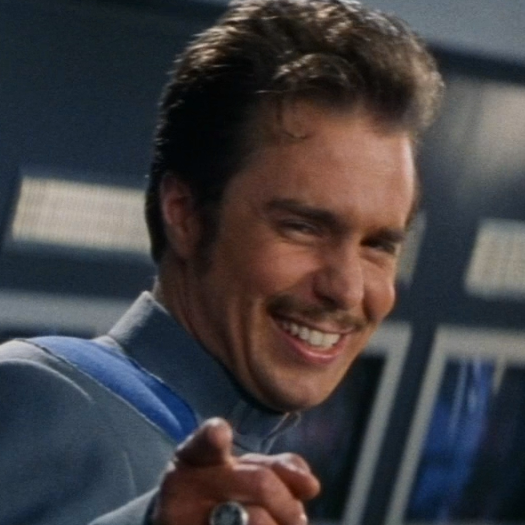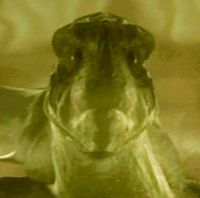Up until the “modern era” of Trek, my understanding of canon is that the Eugenics War happened in the 1990s and was immediately followed by WW3. It seems like that has changed.
Picard season 2 took place in the 2020s, and there was no evidence of widespread devastation that would have taken place in a major war, although it could be argued that it wasn’t shown to us on-screen. At the end of the series, we see a folder labeled “Project Kahn,” hinting that either Kahn has yet to be born or that the season’s “bad guy” is planning to continue Kahn’s legacy.
In Strange New Worlds Season 2, Episode 3, the focus is on Kahn and how he affects the timeline. We see Kahn as a child, meaning the Eugenics War has yet to take place, even though the episode takes place in what is obviously 2020s or 2030s Toronto. Even more telling is that the Romulan spy says “This should have happened in 1993.” Might have been 1992; still, early 1990s.
This leaves me with a few questions. If the Federation time-cops are so set on preserving the timeline, why did they allow the timeline to be altered to such a degree that the Eugenics War, a major event in Humanity’s history, happened at least 30 years after it was supposed to. In addition, what event actually altered the timeline so that Kahn was born/created decades later than he should have been? As far as I remember, we haven’t seen anything to show why this happened.
Since we now know from SNW that the Eugenics War happened some time after the 2020s, how does that fit into the timeline for Zefram Cochrane’s first warp flight? Assuming the Eugenics War is still followed by WW3, that only leaves a max of 49 years between the start of 2 major conflicts and first contact with the Vulcans. In “First Contact,” Cochrane and company assumed the Borg attack was from a hostile force on Earth. Perhaps WW3 was still in progress, and the events of 2069 were what ended the war?
On a side note, the destruction of a single ship spawned the Kelvin timeline. Since SNW shows us that events in Earth’s history no longer match up with the timeline established in TOS, TNG, VOY, and DS9, does this mean that SNW (and possibly PIC) are also in a non-prime timeline?
It’s almost as if time itself is pushing back and events reinsert themselves and all this was supposed to happen back in 1992 and I’ve been trapped here for 30 years!
This line is a pretty conspicuous breach of the fourth wall placed there by the current stewards of the franchise to tell us that we’re back to pre-Kelvin timeline time travel rules. The whole “time travel creates two discrete timelines” notion is gone. It was a one-off to justify the Kelvin timeline, and now we’re done with it.
It’s all one timeline and while that timeline is in a constant state of flux due to time travelers tinkering with it on a regular basis, it’s still one big wibbly-wobbly timey-wimey timeline. Therefore, the answer to every “are X and Y in the same timeline?” question is a continuously shifting “maybe” which largely depends on how you choose to understand “the timeline.”
To put a finer point on it, this is the writing staff telling the fanbase to chill out about timelines. Akiva Goldsman speaking to CinemaBlend, emphasis mine:
This is a correction. Because otherwise, it’s silly, or Star Trek ceases to be in our universe…By the way, this happened in Season 1, so this is not a Season 2 [issue]. It’s a pilot issue. We want Star Trek to be an aspirational future. We want to be able to dream our way into the Federation as a Starfleet. I think that is the fun of it, in part. And so, in order to keep Star Trek in our timeline, we continue to push dates forward. At a certain point, we won’t be able to. But obviously, if you start saying that the Eugenics Wars were in the 90s, you’re kind of fucked for aspirational in terms of the real world.
Translation: the Star Trek canon is going to keep shifting forward to accommodate keeping it in our future. More broadly, we should all accept some measure of canon flexibility so Star Trek is always set in an aspirational future, well suited for telling morality tales in space which are relevant to modern issues.
The Star Trek canon is going to keep shifting forward to accommodate keeping it in our future,
That was how I read it.
Personally I prefer Trek just being it’s own timeline with its own history and not treated as part of our future anymore. It’s clear we’re headed for The Expanse instead of Trek at this point anyway.
Assuming the Eugenics War is still followed by WW3, that only leaves a max of 49 years
What’s so unusual about that? Consider how close World War 1 and World War 2 were to each other. Consider how infrequent global peace is generally.
The Bell Riots and the Irish reunification both happened in 2024 according to DS9 and TNG respectively. How do those slot in after the Eugenics Wars and WW3? The San Francisco in “Past Tense” doesn’t look like it’s in the Post Atomic Horror.
Thats a good point, although we do know from ST2 and SNW that the Eugenics War originally happened in the 1990s. Based on what you’re saying, that would indicate that the timeline change happened some time between the events of ST2 and TNG.
That was established by Roddenberry himself in the TNG pilot Encounter at Farpoint.
TOS fairly clearly implied that the Eugenics wars fed into WW3. Roddenberry insisted that WW3 was situated in the late middle 21st century as of TNG.
All SNW has done make this clear and give a reason why. Otherwise, we’re stuck with the Eugenics War and Khan ruling over a quarter of the planet in the 1990s being some kind of secret cabal thing.
Wasn’t that how the books established the eugenics wars, that the augments were working behind the scenes and influencing things?
Novelverse author Greg Cox’s attempt, to ‘dance between the raindrops’ to explain away a major 1990s war in Trek canon that no one could see in real life, was quite inspired.
There were however still numerous unexplained inconsistencies.
Beyond the ‘how is it really a war if no one knows it’s happening?’ aspect, there has been an inconsistency ever since TNG’s premiere Encounter at Farpoint pushed the timing of World War III back to the latter half of the 21st century.
Given this shift was based in Roddenberry’s own direction, Akiva Goldsman has a strong point that the Great Bird wanted the Trek universe to always stay a possible one for current viewers. As it happens, we can attribute the biggest shift in the Prime timeline to Roddenberry. There seem to have been further tweaks, but moving Khan’s birth to a later time seems a direct corollary of Roddenberry’s fiat in 1987.
TOS is fairly clear that the Eugenics War was the precursor of WW3, but TNG implied they occurred more than a half apart unless the timing of Khan’s rule and the Eugenics War is pushed back. Not to mention the hand waving to explain how none of us noticed Khan ruling a large portion of the global population.
While many don’t remember, this apparent discontinuity was a reason some TOS fans argued in the late 1980s TNG wasn’t in the same continuity as TOS.
Then there are other discrepancies such the later development of the Warp Drive and all the other Berman-era episodes that implied a shifted timeline. Voyager’s findings of temporal interference in 1990s California and the development of computer technology seem to imply that the writers were working off a bible with a revised timeline all along.
Greg Cox himself finds the explanation of accumulating effects of intertemporal interference to be a better solution. You can find his view on this in the comment section under Di Candido’s review of the episode Tomorrow and Tomorrow and Tomorrow.
Another Trek author, Christopher L Bennett who wrote the Department of Temporal Investigations books, also weighed in positively on the episode. He attempted to figure out when the major perturbations in the Prime Universe’s river of time took place, with Encounter at Farpoint being the first major one.
If the Federation time-cops are so set on preserving the timeline, why did they allow the timeline to be altered to such a degree that the Eugenics War, a major event in Humanity’s history, happened at least 30 years after it was supposed to.
For what it’s worth, I wouldn’t characterize them as “allowing” the timeline to be altered. They seem to be hard at work fighting to keep it as intact as possible.
As far as being a “separate timeline”, it depends on where you draw the line. Being strict about it, one could argue that every single instance of time travel creates a separate timeline, so we witness dozens of assorted timelines throughout the shows, starting all the way back in the first season of TOS. Generally, however, we tend to refer to timelines as distinct only if there are substantial differences in the course of history, and “substantial” is subjective. In-universe, there definitely seems to be a certain degree of “good enough” when it comes to “restoring the timeline”, even if minor changes persist. Until we see a substantial contradiction of events between SNW/PIC and TOS/TNG/etc, I’d say it’s premature to declare them completely separate timelines.
(And, from a production perspective, it certainly seems like the intent is that SNW and PIC are “prime timeline”. SNW just had a time travel crossover with LDS with no apparent references to crossing into an alternate timeline, and PIC S3 was filled with direct references to the events of TNG.)
This leaves me with a few questions. If the Federation time-cops are so set on preserving the timeline, why did they allow the timeline to be altered to such a degree that the Eugenics War, a major event in Humanity’s history, happened at least 30 years after it was supposed to.
Maybe they were unable or unwilling to stop it? Either it was from a time-incursion that they’re not sure that they could interfere with, or it was something that, from their viewpoint, didn’t actually cause any major issues, similar to Voyager arriving home several decades earlier thanks to Admiral Janeway’s intervention, or Professor Rasmussen having his timeship stolen, and the thief going to the 24th century to steal technology and “invent” it in the 22nd.
Since we now know from SNW that the Eugenics War happened some time after the 2020s, how does that fit into the timeline for Zefram Cochrane’s first warp flight?
I don’t think that that would change much. All that really needs to happen for the same events to take place is some devastating conflict around the mid-21st century, and that’s still plenty of time for Sloane and Cochrane to invent warp drive, and test it out thanks to some help from the future.
Assuming the Eugenics War is still followed by WW3, that only leaves a max of 49 years between the start of 2 major conflicts and first contact with the Vulcans.
That’s still plenty of time, especially if one thing lead to another. It’s not implausible that the Eugenics War was a precursor conflict that went global. The gap between the Korean and Vietnam wars was only a single year. We know that at the very least, WW3 was a nuclear exchange, leading into the Atomic Horror, so it’s not implausible that the actual WW3 conflict was extremely short.
In “First Contact,” Cochrane and company assumed the Borg attack was from a hostile force on Earth. Perhaps WW3 was still in progress, and the events of 2069 were what ended the war?
I doubt it, but it’s not implausible that that would be the conclusion that Cochrane and Company would leap to. They were used to WW3, and up to that point in time, aliens were not confirmed to exist. The most logical assumption would be that it was a hostile attack from another Earth force, rather than cybernetic grey men.
Cochrane and Co weren’t military or government forces, either. They were civilians, which means that they would not be privy to any intelligence or evidence that might indicate the presence of aliens and inhabited life. Aliens would have no reason to start blowing up civilian infrastructure.
Personally, I think that the war continued for some time, and the Vulcan presence announcing themselves to various governments either put a stop to it as everyone scrambled to realise that aliens with superior firepower existed, or the Vulcans inserted themselves into Earth’s leadership and ended the wars that way. Dangling the stick of comparatively advanced alien space-weapons would be a tempting prospect.
Alternatively, the war had already ended before 2069, and Cochrane was one of the survivors of the atomic horror.
Since SNW shows us that events in Earth’s history no longer match up with the timeline established in TOS, TNG, VOY, and DS9, does this mean that SNW (and possibly PIC) are also in a non-prime timeline?
No, time travel is strange and flexible. Sometimes the destruction, or non-destruction of a single ship, like the Enterprise-C alters the main timeline, sometimes it branches the timeline instead.
We know that from a production standpoint, at least, the Narada incursion was stated to have bidirectional effects on the timeline, so it is possible that the alternative timeline was created when the cumulative changes were too great to reconcile with it. At the very least, it is one of the few time-travel incidents, involving the future ending up in the past, that is not a closed loop.
Discovery S3 also suggests that the Kelvin timeline was also involved in the time war to some degree, which might have further complicated matters. If they also had their own time agents that were trying to maintain the Kelvin timeline’s events (not unlikely), that might have also helped cement it off-screen, since it would no longer converge with the prime timeline.
I feel like, to answer why the federation time-cops are letting this slide is because fundamentally, it doesn’t change much, the events still happen and affect the current galactic-chrono-political thing they have going on, and if they do interfere they could be facing an all-out time-war/“Temporal Hot War” with factions like the Sphere-Builders, Romulans, Na’Kuhl, The Mysterious Benefactor of the Suliban, and other factions that have not been revealed. So I’m willing to think that they are letting that slide so that the timeline isn’t damaged irreparably. And they do state that the Temporal Cold War and its factions are trying to eliminate Khan since he’s the focal point of the Federation’s creation (and kind of what separates our timeline from Star Trek’s), they’ve pushed back Khan 30 years. She does say that she arrived in 1992 and was waiting 30 years to kill him.
To answer your second question and side note, those events will still fit. Just because Khan was moved up doesn’t change the whole timeline. To be fair, in “Past Tense” and “Future’s End”, those cities don’t exactly look like they’ve been ravaged by war, so it’s more likely TNG, VOY, DS9, and SNW are their own timeline rather than TOS, TNG, VOY, and DS9. Plus, 49 years is more than enough time to have 2 wars in, especially if they happened back to back.
And, to be fair, Star Trek isn’t exactly a strict timeline. We see some differing events all over, probably because Star Trek likes to give things dates. This doesn’t necessarily mean it’s a new timeline, just that the events happened other than what is said. Temporal Events in Star Trek are supposed to be taken with a grain of salt.





